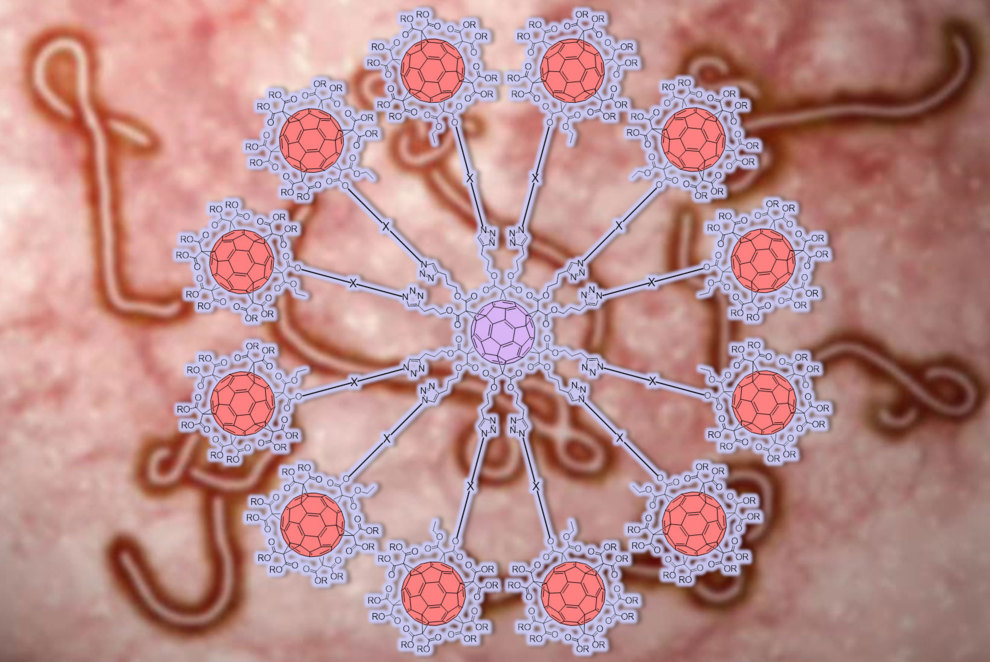A multidisciplinary team, in which Javier Rojo, a researcher at the Institute of Chemical Research at cicCartuja, has participated, has managed to design an in vitro molecule capable of blocking the Ebola virus. The research has included the participation of the Research Institute of the Hospital 12 de Octubre i+12, the Complutense University of Madrid and the Madrid Institute of Advanced Studies in Nanoscience. Through joint work, it has been possible to design a sugar-coated macroparticle capable of preventing the infection of cells by the Ebola virus, artificially modified for safety reasons. The research appears published in the latest issue of the journal Nature Chemistry.
The conclusions of the study, which has also included the participation of the universities of Strasbourg in France and Namur in Belgium, show that this macromolecule is capable of blocking the access of Ebola through the receptor molecule DC-SIGN, located in dendritic cells, responsible for the initiation of the immune response. These cells are the first to recognise the entry of foreign agents, such as viruses, and are responsible for phagocytosing and destroying them.
“However, the Ebola virus can alter its normal functioning and, instead of being a blocking mechanism, turn it into a free access door in the cells, managing to infect them and then spread throughout the body,” explains Rafael Delgado, a researcher at i+12 at Hospital 12 de Octubre. Delgado highlights that his group already characterised the DC-SIGN receptor in dendritic cells in 2002 as a way for the virus to enter the body. “For these studies we have used a safe model of this virus, since it cannot replicate, but it allows us to explore all its behaviour of cell selection and infection,” he explains.
“This large sugar ball has been built from a carbon molecule, the C60 fullerene. Its three-dimensional structure, similar to a football, has allowed up to 12 more units of this element to be connected by chemical bonds. The result is a globular superstructure coated with mannose, the same type of sugar that Ebola has on its surface,” adds Javier Rojo.
Scientists from the Microbiology Service of the Hospital 12 de Octubre have demonstrated in in vitro studies that this designer macromolecule has “an extraordinary antiviral activity” that is in the nano-molar range, that is, the compound could be diluted a billion times in a liquid medium and would be able to maintain the effectiveness of blocking the receptor to prevent the virus from entering the cells. “However, this is a first step, although promising, that must be tested in models of infection with complete viruses in experimental animals,” Delgado emphasizes.
The results highlight the potential of these new macromolecules designed in the laboratory to protect against infections. At the same time, the door is opened to the development of new strategies for the creation and preparation of systems that will allow us to combat infection by pathogens, against which current therapies are not effective or simply do not exist, as is the case with the Ebola virus.
More information: Antonio Muñoz, David Sigwalt, Beatriz M. Illescas, Joanna Luczkowiak, Laura Rodríguez, Iwona Nierengarten, Michel Holler, Jean-Serge Remy, Kevin Buffet, Stéphane P. Vincent, Javier Rojo, Rafael Delgado, Jean-François Nierengarten y Nazario Martín. Synthesis of giant globular multivalent glycofullerenes as potent inhibitors in a model of Ebola virus infection. Nature Chemistry. DOI: 10.1038/nchem.2387




